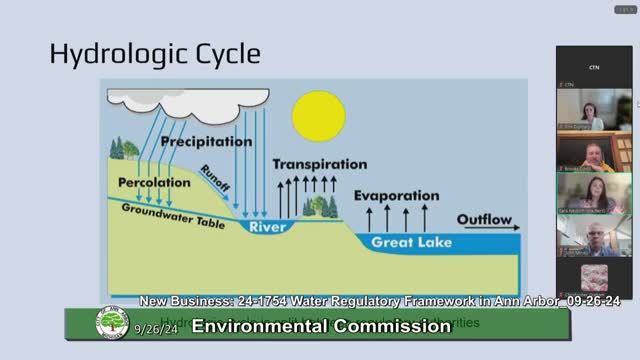Water Regulation Chaos Exposed as Agencies Struggle to Enforce Laws
September 26, 2024 | Ann Arbor City, Washtenaw County, Michigan
This article was created by AI summarizing key points discussed. AI makes mistakes, so for full details and context, please refer to the video of the full meeting. Please report any errors so we can fix them. Report an error »

In a recent government meeting, officials discussed the complexities of water regulation across various agencies, highlighting the fragmented nature of oversight for groundwater, surface water, and atmospheric water. The meeting underscored the challenges posed by the lack of communication between different regulatory bodies, which include the Environmental Protection Agency (EPA), the U.S. Department of Agriculture (USDA), and the National Oceanic and Atmospheric Administration (NOAA), among others.
Key points raised included the limitations of regulatory authority, with some agencies lacking the necessary enforcement mechanisms—referred to as \"teeth\"—to impose penalties for violations. This gap in authority can hinder effective regulation, particularly in cases of nutrient pollution where fines may not be applicable.
Funding and staffing shortages were also identified as significant barriers to proactive environmental management. One speaker shared their experience managing numerous contaminated sites with limited resources, emphasizing the reactive nature of many agencies' responses to environmental issues.
The meeting provided an overview of the roles of various federal and state agencies in water regulation. The EPA was noted as the primary federal authority under the Clean Water Act, responsible for monitoring surface water and drinking water quality. In contrast, the USDA's programs are largely voluntary, offering incentives for farmers to engage in conservation practices without strict penalties for non-compliance.
State agencies, such as the Michigan Department of Environment, Great Lakes, and Energy (EGLE), were highlighted for their roles in groundwater regulation and monitoring, while local health departments manage groundwater use permits and private well sampling.
The discussion also touched on the importance of collaboration among agencies to address water quality issues effectively. As the meeting concluded, participants acknowledged the need for improved communication and resource allocation to enhance the regulatory framework governing water resources.
Key points raised included the limitations of regulatory authority, with some agencies lacking the necessary enforcement mechanisms—referred to as \"teeth\"—to impose penalties for violations. This gap in authority can hinder effective regulation, particularly in cases of nutrient pollution where fines may not be applicable.
Funding and staffing shortages were also identified as significant barriers to proactive environmental management. One speaker shared their experience managing numerous contaminated sites with limited resources, emphasizing the reactive nature of many agencies' responses to environmental issues.
The meeting provided an overview of the roles of various federal and state agencies in water regulation. The EPA was noted as the primary federal authority under the Clean Water Act, responsible for monitoring surface water and drinking water quality. In contrast, the USDA's programs are largely voluntary, offering incentives for farmers to engage in conservation practices without strict penalties for non-compliance.
State agencies, such as the Michigan Department of Environment, Great Lakes, and Energy (EGLE), were highlighted for their roles in groundwater regulation and monitoring, while local health departments manage groundwater use permits and private well sampling.
The discussion also touched on the importance of collaboration among agencies to address water quality issues effectively. As the meeting concluded, participants acknowledged the need for improved communication and resource allocation to enhance the regulatory framework governing water resources.
View full meeting
This article is based on a recent meeting—watch the full video and explore the complete transcript for deeper insights into the discussion.
View full meeting
